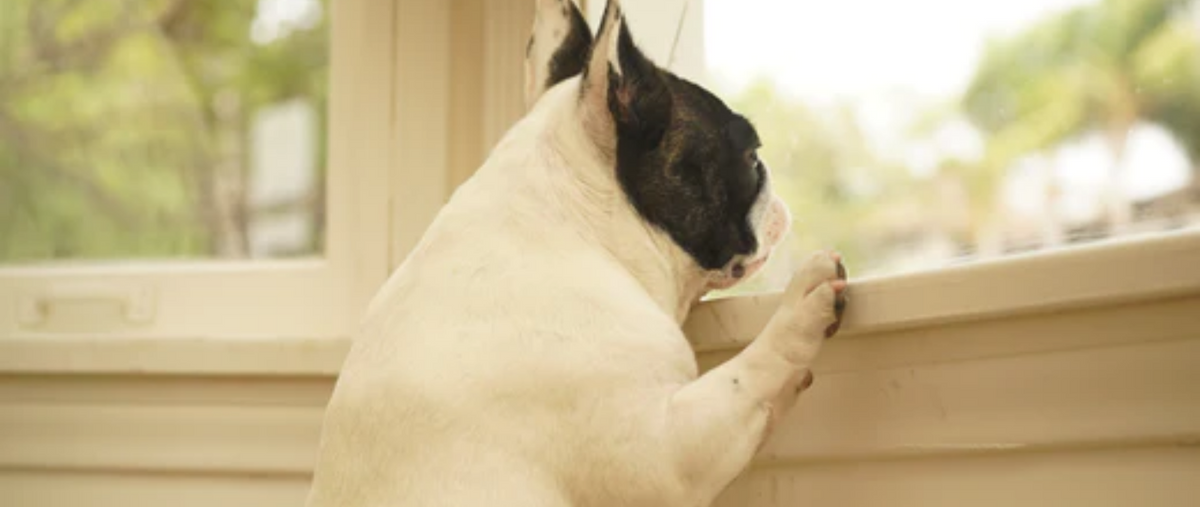Your Cart is Empty

Separation Anxiety in Dogs
|
|
Time to read 5 min
|
|
Time to read 5 min
The bond formed is profound and deeply emotional in the intricate dance of companionship between humans and their canine friends. With their unwavering loyalty and affection, dogs often regard their human counterparts as the center of their universe. The depth of this bond, while beautiful, can sometimes lead to challenges, particularly when it comes to the issue of separation anxiety. It's a condition that affects the dog and the owner, manifesting in behaviors that can disrupt the harmony of home life. But fear not, for understanding and addressing separation anxiety in dogs is possible and can strengthen the bond you share with your furry friend.
Separation anxiety in dogs is a state of distress and agitation experienced by some pets when separated from their owners. It's characterized by an excessive attachment to the owner, leading to a spectrum of anxious behaviors when left alone. This condition is not a reflection of poor training or disobedience but rather a cry for help from your pet, signaling their discomfort with solitude.
The genesis of separation anxiety can vary, stemming from a lack of habituation to being alone during their early stages of development, to significant changes in their environment or routine, such as a move to a new home, alteration in the family structure, or even a change in work schedules. Recognizing these triggers is the first step in crafting a tailored approach to alleviation.
Separation anxiety manifests in several behaviors, notable among them are:
Observing these signs can help diagnose the issue, allowing for a more focused approach to management and treatment.
The initial step should always be a consultation with a veterinarian to rule out any underlying medical issues that could be contributing to the behavior. Once health concerns are cleared, a plan can be formulated.
Training your dog to be comfortable with solitude involves gradual exposure to being alone, starting with short absences and incrementally increasing the duration. This process requires patience and consistency, aiming to desensitize their anxiety over time.
Minimizing the fanfare around departures and returns can help normalize these events for your dog, reducing the association of these moments with heightened emotion or stress.
Offering puzzle toys filled with treats (ensuring they are high quality and healthy, as recommended by brands like HAPPYBOND) can provide a positive distraction, making the time apart more bearable by keeping their minds engaged.
The market offers a variety of aids, from anti-anxiety clothing designed to provide comforting pressure to supplements and CBD oil that may help soothe their nerves.
In cases where separation anxiety is severe, enlisting the help of a professional dog trainer who employs positive reinforcement techniques can be invaluable.
Such experts can offer tailored strategies and support to navigate through anxiety effectively.
In conclusion, while separation anxiety in dogs presents a challenge, it is not insurmountable. With understanding, patience, and the right approach, it is possible to alleviate the stress associated with separation, enhancing the quality of life for both you and your beloved pet.
Remember, the goal is not just to treat the symptoms but to address the underlying emotional needs of your dog, reinforcing the bond and trust between you.
Through concerted efforts, guided by expert advice and a commitment to your dog's well-being, the journey towards overcoming separation anxiety can also be a path to a deeper connection and understanding between you and your furry companion.
"A dog's love is unconditional, and that's something we can all learn from."
Separation anxiety in dogs is a condition where a dog experiences extreme stress and anxiety when separated from their owners.
Excessive barking, destruction, and accidents in the house characterize it.
The leading causes of separation anxiety include:
Dogs with a history of abandonment or rehoming may also be more susceptible.
Symptoms include destructive behavior, excessive barking, attempts to escape, restlessness, drooling, and, in some cases, withdrawal or immobility.
Diagnosis should involve a thorough behavioral assessment by a veterinarian or a certified animal behaviorist to rule out medical issues or other behavioral problems.
The first steps include:
Yes, puzzle toys can provide mental stimulation and reduce boredom, helping alleviate some anxiety associated with separation.
Supplements such as CBD oil and specific anti-anxiety formulations can be effective but should always be used under veterinary supervision.
Positive reinforcement training helps by rewarding calm behavior and teaching the dog that being alone can be a positive experience.
Regular exercise can help reduce overall anxiety levels in dogs, making them more relaxed when left alone.
Crate training can provide a safe and secure environment for anxious dogs, but it's not suitable for all dogs, especially those with severe anxiety.
Creating a calm environment involves:
Avoid punishing your dog for anxiety-related behaviors, as this can increase stress and anxiety.
Anti-anxiety clothing, like weighted vests or anxiety wraps, can provide a sense of security to some dogs, helping to alleviate stress.
If your dog's separation anxiety is severe or initial interventions do not improve, seeking help from a professional dog trainer or a veterinary behaviorist is recommended.
While separation anxiety can be managed and significantly improved, some dogs may always have a degree of sensitivity. Ongoing management and adjustments may be necessary to keep anxiety at manageable levels.



